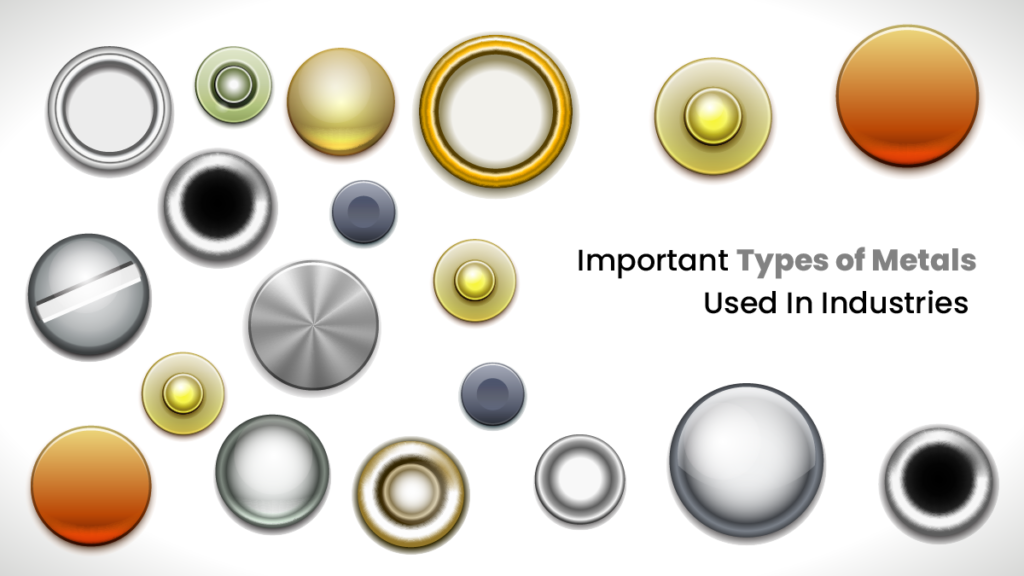Do you know what is the strongest metal in the world?
Tungsten – A metal that is not only known for its strength, but also for being used in filaments to illuminate our homes.
The popularity of metal today was present way before the Industrial Revolution made it popular and possible to bend metals as per our needs. With the advent of new metallurgical technology and advancements in human civilization, application of different metal types has been observed across several industries.
Metals are typically mined using two methods: surface mining (when the mineral is near the surface) and underground mining (when the mineral is deep below the surface).
Excavators, drills, and explosives are used in the mining process to extract minerals from rock and separate the ore and gangue.
The Different Types of Metals And Their Classification
There are numerous metals found in nature. Depending on what property or characteristic you use as a yardstick, they can be classified in a variety of ways.

Based on Ferrous-sciousness
The most common way to categorize them is based on their iron content. A ferrous metal is defined as a metal that contains iron. The iron gives the material magnetic properties while also making it corrosive. Nonferrous metals are those that do not contain any iron. There are no magnetic properties in these metals.
Based on Atomic Structure
They can also be classified using the periodic table based on their atomic structure. When this is completed, a metal is known as alkaline, alkaline earth, or a transition metal. When metals from the same group react with other elements, they behave similarly. As a result, their chemical properties are similar.
Also Read: Semiconductor Shortage: A Worldwide Supply Chain Disruption
Based on Magnetism
Another way to distinguish metals is to observe how they interact with magnets. On that basis, metals can be classified as magnetic or nonmagnetic. While ferromagnetic metals have a strong attraction to magnets, paramagnetic metals have only weak interactions. Finally, there is a class of metals known as diamagnetic metals, which have a weak repulsion to magnets.
Important Types of Metals Used In Industries
There are several factors to consider when selecting a suitable metal for a specific application. These variables include machining ease, melting point, available space, adequate safety factors, temperature coefficient, density, and electrical and thermal conductivity. Let’s take a look at the different types of metals and why they’re used in certain applications.
Iron
Iron makes up nearly 5% of the Earth’s crust. As a result, it is a common metal. However, pure metal is not a stable element because it quickly reacts with the oxygen in the air, forming iron oxide.
A blast furnace is required to extract iron from its ores. The blast furnace’s first stage produces pig iron, which can be refined further to produce pure iron. This iron is typically used to make steel and other alloys. As a result, nearly 90% of manufactured metals are ferrous in nature.
Steel
Although pure iron is stronger than most metals, it corrodes easily. It will take a lot of effort and money to keep corrosion at bay. Because of its high density, iron is also extremely heavy.
To some extent, these weaknesses were mitigated by adding carbon to iron. Carbon steel is formed when carbon and iron combine to form carbon steel, which is stronger than iron. As a result, steel is widely used in construction. Steel is classified into three types based on its iron content: low carbon steel, medium carbon steel, and high carbon steel.
Copper
When discussing various metals, it is impossible to overlook copper. Copper is easy to form, which is why it has a long history, and the applications it has today are the most visible manifestations of its importance. Because copper does not exist in its purest form in nature, smelting and extracting it from its ore is critical.
Metals are good conductors, but copper is the best. Copper conductor wires are used in electrical circuits due to their exceptional electrical conductivity. Silver is the only metal that can outperform copper in terms of conductivity. This could explain why most cooking utensils are made of copper.

Bronze
Bronze is a copper alloy as well. Bronze, on the other hand, contains tin, as opposed to zinc. You can improve its properties and suitability for a particular application. Bronze is a hard, brittle metal that is resistant to fatigue. Bronze has excellent thermal and electrical conductivity, as well as resistance to corrosion. Bronze is used in the manufacture of reflectors and mirrors. It is also used in electrical connectors. It is used in ship fittings and submerged parts due to its corrosion resistance.
Brass
Brass is a zinc and copper alloy. Because of the mechanical and electrical properties sought from the metal, the amount of each metal may vary. It contains traces of several metallic elements, including manganese, lead, and aluminum.
Brass is an excellent choice for low friction applications such as bearings, locks, musical instruments, tools and fittings, and plumbing. Brass is required in inherently safe applications to allow use and prevent sparks in flammable environments.
Aluminum
Aluminum is primarily derived from its ore, bauxite. It is the most common metal on Earth and is strong, light, and functional. This is due to its properties, which include being lightweight, durable, electrically conductive, and corrosion resistant; it can form alloys with almost any metal. Aluminum is lightweight and does not magnetize.
Titanium
Titanium is an important engineering metal due to its lightweight and strength. It also has excellent thermal stability, even at temperatures as high as 480°C. These properties are why they are typically used in the aerospace industry.
It is also used in military equipment and, due to its corrosion resistance, it is used in medical applications. Titanium can also be found in sporting goods and the chemical industry.
Lead
Lead is a machinable, corrosion-resistant metal. Some of its applications include piping and painting. It was used in gasoline as an anti-knocking delegate. It was later discovered that one of its byproducts could cause serious health problems. Lead can be found in automobile batteries, ammunition, lifting weights, radiation protection, and cable sheathing.
Projections Into the Future
The rising amount of metal consumption across the globe complemented by the rapid industrialization is expected to fuel the metal recycling industry. The growing concern on curbing CO2 emissions and achieving ‘Net Zero’ will be the flagbearer in this movement. Metal utility in the future is going to be about using all types of metals with responsibility and environmental impact awareness.



